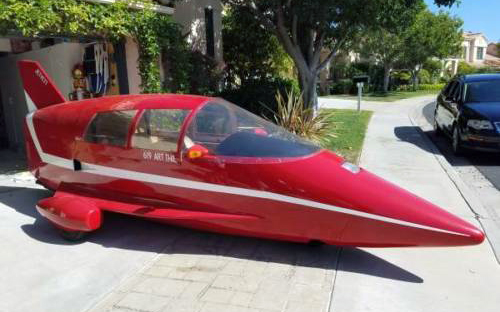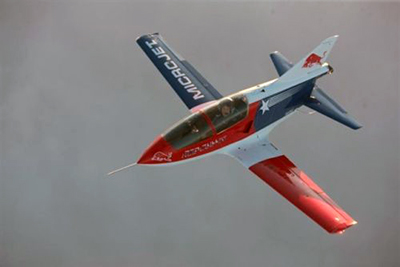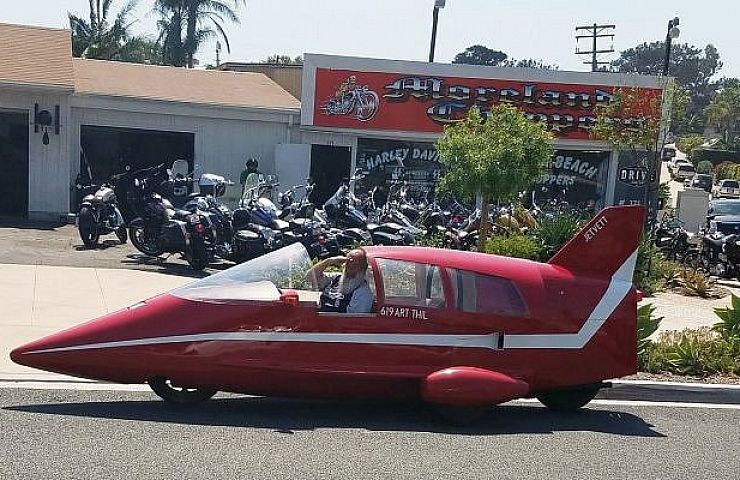It’s not surprising that the Litestar Pulse vehicle now listed on eBay looks like a road-bound fighter jet. That’s because it was designed by Jim Bede, the visionary and somewhat controversial aeronautic engineer who tried to make low-cost aircraft affordable for the masses.

The LiteStar Pulse is part-motorcycle and part-car. It’s design resembles the small kit planes previously created by Jim Bede.
Bede didn’t try his hand at making his own kit car until after spending decades trying to design a plane that could be priced for the average consumer. His main idea was that the labor costs for building a plane prevented pilots from owning their own aircraft. The solution: produce a kit that allowed pilots to build their own.
He designed the Bede BD-1, his first kit-built plane, in 1961. The low-wing two-seat BD-1, powered by a 65-horsepower engine, had a relatively simple design. The novelty was the ability to fold the plane’s wings, so you could park it at home in a garage—and then tow it to the airstrip when ready to take to the skies.
Commercialization of the concept proved difficult for Bede. Throughout the 1960s, Bede produced a series of design iterations—each one holding the potential for an easy-to-build but highly competent small airplane. Despite big promises and impressive demonstrations, his creations invariably resulted in cost overruns, crashes, bankruptcies, and changes of ownership—each time sending Bede back to the drawing board to reinvent his planes and himself.

A semi-built 1972 BD-5 is now up for auction on eBay.
The pinnacle of Bede’s career arguably was the BD-5, introduced in the early 1970s. It had multiple variants, including the BD-5J, which was considered the world’s smallest jet for a couple decades. A few thousand kits and plans were produced and sold. The BD-5J garnered fame in the early 1980s, when it appeared in the opening sequence of Octopussy, the 1983 James Bond movie. Also, Budweiser used it as the “Bud Light Jet” for promotions at events and air shows—that is, until the aircraft was lost due to an engine fire.
During this period, Bede also produced a car/motorcycle known as the LiteStar Pulse (or the Bede Car, Autocycle, or BD-200). The nomenclature is tricky: the first 40 were officially called LiteStar and then the name switched to Pulse, although sometimes the names are jammed together.
The shape of its aluminum and fiberglass shell bears an obvious resemblance to the BD-5—although the LiteStar Pluse was never intended for extraterrestrial travel. About 350 LiteStar Pulses were produced—including the example now available on eBay. (The seller lists the car as a 1978 model, but most accounts indicate that production started about four years later.)
According to the seller, the LiteStar Pluse for sale is powered by a 1.1-liter Honda Goldwing motorcycle engine with a manual transmission. In fact, it’s registered as a motorcycle with current California registration and tags. The seller recently spent about $2,000 to upgrade all four carburetors, improve the electrical systems, and put the gauges into good working order. “It runs very well now,” states the seller.
Two passengers can fit, in a line, inside the plane-like cockpit. Newspaper accounts in the era reported a zero to 60-mph performance of six seconds and a top speed of 180 miles per hour. That sounds like a rollicking time, but simply parking this LiteStar Pulse in your driveway will earn you a ton of attention. There’s also an active set of owners and fans awaiting your arrival at the autocycles.org online community. The 2016 International Litestar & Pulse Convention took place last weekend in Marion, Ind.






